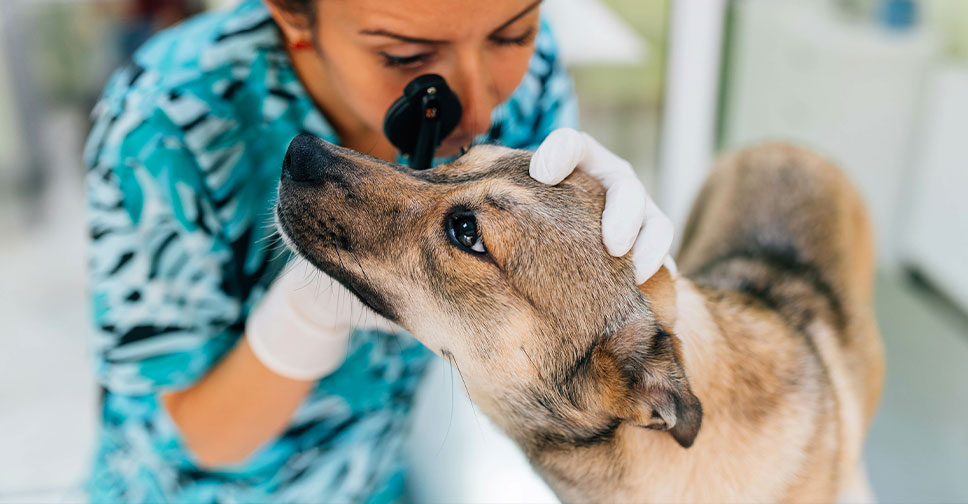
Distichiasis, Trichiasis and/or Ectopic Cilia Surgery
(Bilateral trans-palpebral conjunctival resection and/or focal nitrous cryotherapy)
Distichiasis is a condition that affects dogs and cats in which an additional row of eyelashes, known as distichiae, grow from the meibomian gland ducts on the inner surface of the eyelids. These extra eyelashes may grow inwards towards the eye and meet the cornea, causing irritation, redness, and sometimes even corneal ulcers.
Distichiasis is usually a hereditary condition, and certain breeds are more predisposed to developing it, such as Cocker Spaniels, Bulldogs, and Shih Tzus. However, it can also occur because of other conditions, such as eyelid trauma or inflammation.
Symptoms of distichiasis may include excessive blinking, squinting, rubbing, or pawing at the eye, and discharge from the eye. In more severe cases, the cornea may become scarred or even perforated, leading to impaired vision.
Treatment for distichiasis usually involves the surgical removal of the extra eyelashes. This can be done using several techniques, such as cryotherapy or surgical excision. The choice of technique will depend on the severity of the condition and the individual pet’s needs.
It’s important to note that distichiasis is a chronic condition, and there is a risk of regrowth of the extra eyelashes after treatment. Therefore, regular check-ups are essential to monitor your pet’s condition and catch any recurrence early. With proper management, however, most pets with distichiasis can lead happy, healthy lives.
Trichiasis is a condition that affects dogs and cats in which the eyelashes grow in the wrong direction and rub against the surface of the eye, causing irritation and discomfort. Unlike distichiasis, where there is an extra row of eyelashes, trichiasis occurs when the normal eyelashes grow inwards towards the eye.
Trichiasis can be caused by several factors, including eye infections, inflammation of the eyelids (blepharitis), eyelid trauma, or eyelid abnormalities. Certain breeds of dogs, such as Pugs, Shih Tzus, and Bulldogs, are also more prone to developing trichiasis.
Symptoms of trichiasis may include excessive blinking, squinting, redness, and discharge from the eye. Long-term rubbing of the eyelashes against the eye can lead to corneal abrasions or ulcers, which can be painful and potentially lead to vision loss if left untreated.
Treatment for trichiasis involves surgical intervention to remove the affected eyelashes or reposition them away from the eye. Cryotherapy may also be used to destroy the hair follicles and prevent further regrowth.
Like with distichiasis, it’s important to note that trichiasis is a chronic condition, and there is a risk of regrowth of the eyelashes after treatment. Therefore, regular follow-up appointments are crucial to monitor your pet’s condition and catch any recurrence early. With proper management and treatment, most pets with trichiasis can lead happy, healthy lives.
Ectopic cilia are a rare anatomical abnormality in which a small piece of eyelash grows out of an abnormal location on the eyelid and rubs against the cornea. This can cause discomfort, inflammation, and potentially serious eye damage if left untreated.
Ectopic cilia surgery is a veterinary surgical procedure performed on pets to remove these abnormal eyelashes. The procedure involves making a small incision in the eyelid and removing the ectopic cilium. In some cases, the surrounding tissues may also need to be removed to prevent the abnormal eyelash from regrowing.
It’s important to have your pet regularly examined by a veterinarian, as ectopic cilia can be difficult to detect without a thorough eye examination. Early detection and treatment can help prevent serious eye damage and discomfort for your pet.
After surgery, pets typically wear a protective cone or collar to prevent them from scratching or rubbing their eyes. Eye drops, ointments, anti-inflammatory medications, or artificial tears may also be prescribed to help healing, alleviate symptoms, reduce inflammation, and prevent further damage to the cornea.
Most pets recover from the surgery quickly and have improved eye comfort and function. However, as with any surgical procedure, there are potential risks and complications, such as infection, bleeding, or eye damage.
